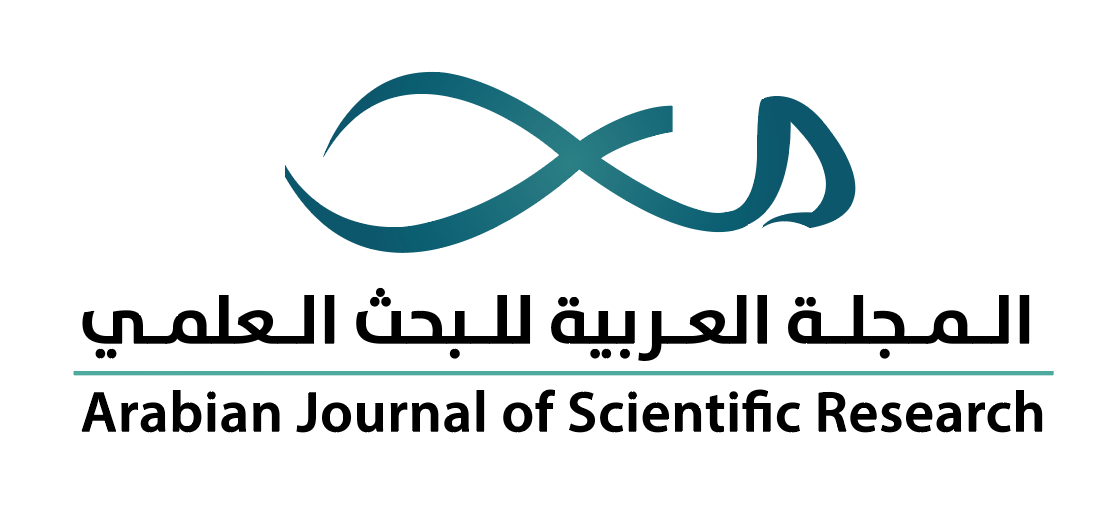-
oa تقييم فاعلية أربعة نباتات طبية وعطرية كمواد تدخين لمكافحة طفيل الفاروا (Varroa destructor) على طوائف نحل العسل Apis mellifera jemenitica
- Source: Arabian Journal of Scientific Research-المجلة العربية للبحث العلمي, Volume 4 (2023), Issue 2, Oct 2023, 15
-
- 23 June 2023
- 03 October 2023
- 09 November 2023
Abstract
الملخص
حشرة نحل العسل من الحشرات الهامة اقتصاديّاً، سواء في تلقيح المحاصيل الزراعية أو إنتاج العسل والشمع والغذاء الملكي وحبوب اللقاح والبروبوليس وسم النحل. تتعرض هذه الحشرة للعديد من الأمراض والآفات الطفيلية، ويعتبر طفيل الفاروا Varroa destructor من أخطر الآفات ضرراً على نحل العسل في العالم أجمع، ولأن طفيل الفاروا أصبح لديه مقاومة للعلاجات الكيماوية هدفت هذه الدراسة إلى اختبار كفاءة أربعة نباتات هي نبات الحَـدَق Solanum incanum ، وإكليل الجبل Rosmarinus officinalis، والبردقوش Origanum majorana، والعُشار Calotropis procera كمدخنات طبيعية لمكافحة الفاروا. تم إجراء الدراسة في محافظة إب بالجمهورية اليمنية، خلال الفترة من 15 مارس إلى 25 ابريل 2022، على خلايا نحل قياسية نوع (لانجستروث) بها طوائف من النحل اليمني Apis mellifera jemenitica، تحتوي كل خلية من 6-7 إطارات (براويز) مغطاة بالنحل، وتم أخذ قراءة التساقط الطبيعي للفاروا لكل المعاملات بما فيها الشاهد قبل التطبيق بعد 3 أيام من وضع قواعد عد الفاروا، ثم بعد 6 و9 أيام على التوالي دون استخدام أي نوع من التدخين؛ وذلك من أجل حساب متوسط التساقط الطبيعي للفاروا.عوملت كل معاملة حسب المادة النباتية المستخدمة تدخيناً من خلال أبواب الخلايا، وأُخذت القراءات بعد 3 و6 و9 أيام على التوالي، وأظهرت النتائج أن استخدام النباتات السابقة تدخيناً لمكافحة حلم الفاروا Varroa destructor أعطت جميعها نتائج جيدة في تساقط حلم الفاروا؛ حيث بلغ أعلى معدل للتساقط بعد المعالجة بنبات الحدق (T1) S. incanum بمتوسط 144 حلماً/خلية، بينما كانت أقل نسبة تساقط في معاملة نبات (T3) O. majorana بمتوسط 122.33 حلم/ خلية، وأظهرت النتائج أن معدل تساقط حلم الفاروا الميت بعد المعالجة كان كبيراً خلال الـ 3 أيام الأولى للمعاملات باستثناء الشاهد بمتوسط عام بلغ 83.57% حلم/ معاملة، بينما كانت أقل أعداد الحلم المتساقط عند القراءة بعد 6أيام من المعالجة بمتوسط عام 66.57% حلم/معاملة، وأظهرت النتائج انخفاض معدل تساقط حلم الفاروا الميت بعد 9 أيام إلى أقل من النصف تقريباً مقارنة بالثلاثة أيام الأولى بمتوسط عام بلغ 36.50% حلم/ معاملة. وبالنسبة لمتوسط عدد حلم الفاروا داخل أعين الحضنة المغلقة للشغالات قبل وبعد المعالجة أظهرت النتائج أن نسبة إصابة حضنة الشغالات المغلقة بحلم الفاروا كانت مرتفعة قبل المعالجة لكل المعاملات بما فيها الشاهد بلغ 60%، وبعد المعالجة انخفضت بدرجة كبيرة في جميع المعاملات باستثناء (الشاهد)، وكانت أقل نسبة إصابة تم تسجيلها في معاملة نبات الحدق(T1) S. incanum بنسبة 8.33%.
The honeybee is an economically important insect, whether for pollinating agricultural crops, or for producing honey, wax, royal jelly, pollen, propolis, and bee venom. However, this insect is exposed to various diseases and parasitic pests, whereas the Varroa destructor parasite is considered as one of the most dangerous pests harmful to honeybees in the whole world. As the Varroa parasite has become resistant to chemical treatments, this study aimed to test the efficiency of four plants: Solanum incanum, Rosmarinus officinalis (Rosemary), Origanum majorana, and Calotropis Procera as natural fumigants for Varroa control. The study was conducted in Ibb Governorate in Yemen (during the period March 15th to April 25th, 2022) on standard beehives (Langstroth) with colonies of Yemeni bees Apis mellifera jemenitica. Each cell contained 6-7 frames covered with bees. Readings of the natural precipitation of Varroa were taken for all treatments, including the control, before application, after 3 days of installing the Varroa count rules, then after 6 and 9 days respectively, without using any kind of smoking in order to calculate the average natural precipitation of Varroa. Each treatment was made according to the plant material used for smoking through the doors of the hives and readings were taken after 3, 6 and 9 days, respectively. The results showed that the use of the previous plants by smoking to combat Varroa destructor gave good results in the shedding of Varroa mites, as it reached the highest rate of Varroa mites after treatment with S. incanum (T1) with an average of 144 mites. While the lowest precipitation rate was in treatment O. majorana (T3), with an average of 122.33 mites/cell. The results also showed that the rate of shedding of dead Varroa mites after treatment was significant during the first 3 days of the treatments, with the exception of the control, with an overall average of 83.57% mites/treatment. While the lowest numbers of fallen mites were when the reading was taken after 6 days of treatment, with an overall average of 66.57% mites/treatment. In addition, it was noticed a decrease in the rate of shedding of dead Varroa mites after 9 days to approximately less than half compared to the first three days, with an overall average of 36.50% mites/treatment. As for the average number of Varroa mites inside the eyes of the closed brood of the workers before and after treatment, the results showed that the rate of infection of the closed brood of the workers with Varroa mites was high before treatment for all treatments, including the control, reaching 60%. After treatment, it decreased significantly in all treatments except (the control), and the lowest infection rate was recorded in the S. incanum (T1) treatment, at 8.33%.


